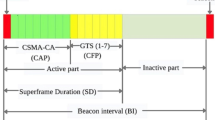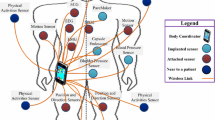Abstract
In recent days, intelligent biomedical sensors and wearable devices are changing the healthcare industry by providing various heterogeneous vital signs of patients to the hospitals, caregivers, and clinicals. This collective form of monitoring sensor devices forms a very short-range Wireless Body Area Network (WBAN) and plays a key role in the data gathering process. If any sensor node in the network detects abnormal values that should be transmitted promptly via wireless medium with less delay. A single medium allows one-way delivery of a data packet, and it may not be sufficient to satisfy the high volume of communication demand between the sensor nodes in the network. In the same way, the packet prioritization does not guarantee the packet will get there on time and sometime it may cause priority conflicts among the nodes. It is only mean that the flow of delivery service handles that critical data packet before handling other data packets. However, unexploited time slots and bandwidth wastage will occur due to inefficient backoff management and collisions. To minimize the aforementioned issues, various backoff procedures, adaptive slot allocation mechanisms, priority-based medium access control protocols have been developed but suffer limitations in the context of providing priority-based channel access with less backoff conflicts and dedicated allocation of time slots for critical nodes in all cases. Based on these deliberations, a more effective Traffic Priority-based Channel Access Technique (TP-CAT) is proposed using IEEE 802.15.6 in order to minimize the transmission delay of critical data packet and solve conflicts among other priority nodes during the backoff phases. Firstly, a Low Threshold Criticality-based Adaptive Time slot Allocation algorithm (LT-CATA) is presented to decrease the priority slot conflicts between the low threshold data traffic from the same and different type of user priority nodes. Secondly, a High Threshold Criticality-based Adaptive Time slot Allocation algorithm (HT-CATA) is developed to reduce the priority slot conflicts between the high threshold data traffic from the same and different types of user priority nodes. Additionally, a novel Random Overlapping Backoff value Avoidance (ROBA) technique is introduced to eliminate the overlapping issue during the selection of random backoff value among the sensor nodes. Since, the proposed technique greatly reduced the channel access delay and transmission delay of critical data packet as well as other types of priority data packet. The Simulation results are verified in the CASTALIA 3.2 framework using omnet++ network simulater to relatively evaluate the performance metrics of the TP-CAT technique with state-of-the-art protocols. From the analysis of the results, it is evident that the TP-CAT technique provides better performance in terms of delay, energy consumption, and throughput in healthcare monitoring environments.












Similar content being viewed by others
References
Freundlich, R. E., Pandharipande, P. and, Ehrenfeld, J. M., A call for electronic health record-based data sharing for clinical trials in critical care. J. Med. Syst., 2018.
Wu, T., Redoute, J.-M., and Yuce, M. R., An autonomous wireless body area network implementation towards IoT connected healthcare applications. IEEE Access, 2017.
Nepal, S., Dahal, S., and Shin, S., Does the IEEE 802.15.4 MAC protocol work well in wireless body area networks. J Adv. Comput. Netw., 4(1), 2016.
Zhang, B., Li, C., Liu, Z., Yuan, X. and Li, Y., On energy-delay efficiency for WBAN: a multi-channel scheme. IEEE/CIC ICCC 2015 Sym Next Gen. Netw., 2015.
Maitra, T., and Sarbani, R., Research challenges in BAN due to the mixed WSN features: some perspectives and future directions. IEEE Sensors J. 17(17):5759–5766, 2017.
Moulik, S., Misra, S. and Das, D., AT-MAC: Adaptive MAC-frame payload tuning for reliable communication in wireless body area networks, IEEE Trans. Mobile Comput., 2016.
Akbar, M. S., Yu, H., and Cang, S., TMP: Tele-medicine protocol for slotted 802.15.4 with duty-cycle optimization in wireless body area sensor networks. IEEE Sensors J. 17(6):1925–1936, 2017.
Sarkar, S. and Misra, S., Performance analysis of IEEE 802.15.6 MAC protocol under non-Ideal Channel conditions and saturated traffic regime. IEEE Trans. Comput., 2015.
Jacob, A. K. and Jacob, L., A green media access method for IEEE 802.15.6 wireless body area network. J. Med. Syst., 2017.
Frigo, G., and Giorgi, G., IEEE 802.15.6 compliant WBSN: a case study. IEEE Instrum. Meas. Soc., 2017.
Hayat, N. J., Khan, Z. A., Shareef, A., Mahmood, A. and Bouk, S. H., Energy efficient MAC protocols. IEEE 14th Int Conf High Perform. Comput. Commun. 1185-1192, 2012.
Salayma, M., AL-Dubai, A., Romdhani, I. and Nasser, Y., Reliability and energy efficiency enhancement for emergency-aware wireless body area networks (WBAN). IEEE Trans. Green Commun. Netw., 2017.
Masud, F., Abdullah, A. H., Abdul-Salaam, G., and Ullah, F., Traffic adaptive MAC protocols in wireless body area networks. Hindawi Wireless Commun. Mobile Comput., 2017.
Ullah, S. and Tovar, E., Performance analysis of IEEE 802.15.6 contention-based MAC protocol. IEEE Conf. Commun. QoS, Reliab. Modell. Sym., 2015.
Bhandari, S. and Moh, S., A priority-based adaptive MAC protocol for wireless body area networks. MDPI Sens. J., 2016.
Huang, R., Nie, Z., Duan, C., Liu, Y., Jia, L., and Wang, L., Analysis and comparison of the IEEE 802.15.4 and 802.15.6 wireless standards based on MAC layer. Int. Conf. Health Inform. Sci. 7–16, 2015.
Movassaghi, S., Abolhasan, M., Lipman, J., Smith, D., and Jamalipour, A., Wireless body area networks: a survey. IEEE Commun. Surv. Tutor. 16(3):1658–1686, 2014.
Ullah, F., Abdullah, A. H., Kaiwartya, O. and Cao, Y., Traffic priority aware adaptive time slot allocation for medium access control protocol in wireless body area network. MDPI Sens. J., 2017.
Shin, H., Kim, Y., and Lee, S., A backoff counter reservation scheme for performance improvement in wireless body area networks. 12 th IEEE Ann. Consum. Commun. Netw. Conf. (CCNC), 2015.
Yuan, X., Li, C., Yang, L., Yue, W., Zhang, B. and Ullah, S., A token-based dynamic scheduled MAC protocol for health monitoring. EURASIP J. Wireless Commun. Netw., 2016.
Li, C., Zhang, B., Yuan, X., Ullah, S., and Vasilakos, A. V., MC-MAC: A multi-channel-based MAC scheme for interference mitigation in WBANs. Springer J. Wireless Netw., 2016.
Deepak, K. S. and Babu, A. V., Energy efficiency analysis of IEEE 802.15.6 based wireless body area networks in scheduled access mode. Springer J. Wireless Netw., 2015.
Liu, B., Yan, Z., and Chen, C. W., Medium access control for wireless body area networks with QoS provisioning and energy efficient design. IEEE Trans. Mobile Comput., 2012.
Wei, Z., Sun, Y. and Ji, Y., Collision analysis of CSMA/CA based MAC protocol for duty cycled WBANs, Springer J. Wireless Netw., 2016.
Rasheed, M. B., Javaid, N., Imran, M., Khan, Z. A., Qasim, U. and Vasilakos, A., Delay and energy consumption analysis of priority guaranteed MAC protocol for wireless body area networks. Springer J Wireless Netw., 2016.
Yu, J., Park, L., Park, J., Cho, S. and Keum, C., CoR-MAC: Contention over reservation MAC protocol for time-critical services in wireless body area sensor networks. MDPI Sens. J., 2016.
Acknowledgements
This research work was supported by the National Fellowship grant funded by the University Grant Commission (Grant No. F1-17.1/2014-15/RGNF-2014-15-SC-TAM-71494). The authors would like to thank the reviewers for their valuable comments and suggestions to improve the quality of the paper.
Author information
Authors and Affiliations
Corresponding author
Ethics declarations
Ethical Approval
All procedures performed in studies involving human participants were in accordance with the ethical standards of the institutional and/or national research committee and with the 1964 Helsinki declaration and its later amendments or comparable ethical standards.
Conflict of Interest
The authors report no financial interests or potential conflicts of interest.
Informed Consent
Informed consent was obtained from all individual participants included in the study.
Additional information
This article is part of the Topical Collection on Mobile & Wireless Health
Rights and permissions
About this article
Cite this article
Ambigavathi, M., Sridharan, D. Traffic Priority Based Channel Assignment Technique for Critical Data Transmission in Wireless Body Area Network. J Med Syst 42, 206 (2018). https://doi.org/10.1007/s10916-018-1054-y
Received:
Accepted:
Published:
DOI: https://doi.org/10.1007/s10916-018-1054-y




